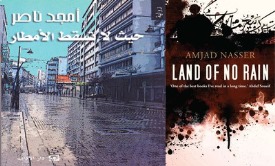This year, 2014CE, hasn’t been a very particularly good one for real-world human ventures. Fortunately, however, it has been an excellent one for Arabic literature in translation: Iman Humaydan Younes’s circling Other Lives; Radwa Ashour’s emotional Tantoureya and Blue Lorries; Sonallah Ibrahim’s compelling Stealth was re-issued; Jabbour Douaihy’s sharp June Rain; two more volumes of the incredible Leg over Leg; several interesting collections. But the book that has made my year, thus far, is Amjad Nasser’s Land of No Rain:
 My review in The Guardian opens:
My review in The Guardian opens:
Land of No Rain begins in a futuristic, plague-wracked London. This might seem an odd start to a semi-autobiographical novel that harks back to classical Arabic forms, but the book is constantly shape-shifting, changing its tone from the academic to the lyric, the romantic to the slapstick.
Amjad Nasser’s debut novel parts company with the western forms that have dominated the Arab literary landscape. The acclaimed poet, with nine collections to his name, is a clear descendant of Arab polymaths. Narrative arc is not fundamental here, and we never learn what happens to the plague’s victims. The jarring opening serves merely to propel the protagonist, Adham Jaber, back to his native Hamiya after 20 years in exile. “Hamiya” is an amalgam of places, most closely resembling the land of the author’s birth, Jordan. The novel’s other cities have equivalents in our world, but most are described rather than named: London is the “City of Red and Grey”, Beirut is the “City of Siege and War”, and Cyprus the “City Overlooking the Sea”. Throughout, we are looking into a slightly different version of our own world, one that is simultaneously familiar and strange.
Soon, we learn that Adham has caught the contagion; perhaps he doesn’t have long to live. Thus, the man once sentenced to life in prison by the Hamiyan regime makes a deal to return home. He searches out family and old friends, and most particularly his old love, Roula. To do this, he must confront his old self of 20 years before, a self with whom he broke psychologically when he left Hamiya and took the pseudonym Adham Jaber.
The novel’s primary conflict is between this former self – fiery communist poet Younis al-Khattat, who fell madly in love with a policeman’s daughter and whose stomach was branded for the possession of banned literature – and his post-Hamiya self. The latter made a new life in Cyprus, Beirut and, finally, London, that city where “many years ago your region was dismembered like a cake at a birthday party”.
Click HERE to read more

Be the first to comment